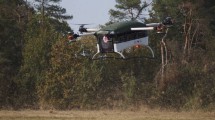Abstract
Battery powered vertical takeoff and landing (VTOL) aircraft attracts more and more interests from public, while limited hover endurance hinders many prospective applications. Based on the weight models of battery, motor and electronic speed controller, the power consumption model of propeller and the constant power discharge model of battery, an efficient method to estimate the hover endurance of battery powered VTOL aircraft was presented. In order to understand the mechanism of performance improvement, the impacts of propulsion system parameters on hover endurance were analyzed by simulations, including the motor power density, the battery capacity, specific energy and Peukert coefficient. Ground experiment platform was established and validation experiments were carried out, the results of which showed a well agreement with the simulations. The estimation method and the analysis results could be used for optimization design and hover performance evaluation of battery powered VTOL aircraft.
Similar content being viewed by others
References
MICHAEL N, SHEN S, MOHTA K. Collaborative mapping of an earthquake-damaged building via ground and aerial robots [J]. Journal of Field Robotics, 2012, 29(5): 832–841.
Drones deployed in quake relief. [2014-10-05]. http://www.chinadaily.com.cn/china/2014-08/05/content_18252904.htm.
NASA Long-Lived Mars Opportunity Sets Off-World Driving record [2014-10-05]. http://www.mars.nasa.gov/mer/newsroom/ressreleases/20140728a.html.
Curiosity makes its longest one-day drive on Mars [OL]. [2014-12-05]. http://www.mars.jpl.nasa.gov/news/whatsnew/index.cfm?FuseAction= ShowNews&NewsID=1498.html.
YOUNG LARRY A, AIKEN EDWIN W. Vertical lift planetary aerial vehicles: Three planetary bodies and four conceptual design cases [C]// 27th European Rotorcraft Forum. Moscow: ERF, 2001: 11–14.
YOUNG L A, PISANICH G, BRIGGS G, AIKEN E. Rotary wing decelerators for probe descent through the atmosphere of Venus [R]. Moffett Field: NASA Ames Research Center, 2004: 209–215.
ZHAO W, UNDERWOOD C. Robust transition control of a Martian coaxial tilt rotor aerobot [J]. Acta Astronautica, 2014, 99: 111–129.
LANGELAAN J W, ROY N. Enabling new missions for robotic aircraft [J]. Science, 2009, 326(326): 1642–1644.
AscTec Pelican [OL]. [2014-10-05]. http://www.asctec.de/en/uavuas-drone-products/AscTecPelican/Details.
STEPANIAK M J, van GRAAS F, HAAG M U. Design of an electric propulsion system for a quadrotor unmanned aerial vehicle [J]. Journal of Aircraft, 2009, 46(3): 1050–1058.
HOGGE J V. Development of a miniature VTOL tailsitter [D]. Provo: Brigham Young University, 2008.
Draganflyer X8 helicopter tech specs [OL]. [2014-10-05]. http://www.draganfly.com/uav-helicopter/draganflyer-x8/specificatio ns.php.
MOSCHETTA J, BATAILLÉ B, THIPYOPAS C, SHKARAYEV S. On fixed-wing micro-air vehicles with hovering capabilities [C]// 46th AIAA Aerospace Sciences Meeting and Exhibit. Reno, Nevada, 2008: 1–13.
HOFFMANN G M, WASLANDER S L, VITUS M P. Stanford testbed of autonomous rotorcraft for multi-agent control [C]// The 2009 IEEE/RSJ International Conference on Intelligent Robots and Systems. St. Louis, USA: IEEE, 2009: 404–405.
BINETTI P, TROUCHET D, POLLINI L, INNOCENTI M. The flight control system of the hovereye VTOL UAV [R]. Neuilly-sur-Seine, France: Bertin Technologies, 2007.
NG T T H, LENG G S B. Design of small-scale quadrotor unmanned air vehicles using genetic algorithms [J]. Proc IMechE, Part G: Journal of Aerospace Engineering, 2007, 221(5): 893–905.
WANG Xin-hua, LIN Hai. Design and control for rotor-fixed wing hybrid aircraft [J]. Proceedings of the Institution of Mechanical Engineers, Part G: Journal of Aerospace Engineering, 2011, 227(10): 1556–1570.
GUR O, ROSEN A. Optimizing electric propulsion systems for unmanned aerial vehicles [J]. Journal of Aircraft, 2009, 46(4): 1340–1353.
BO W, HOU Z, WANG W. Performance of propulsion system of miniature electric-powered vertical takeoff and landing air vehicles [J]. Journal of National University of Defense Technology, 2015, 37(3): 84–90.
LEISHMAN J G. Principles of helicopter aerodynamics [M]. 2nd edition. New York: Cambridge University Press, 2006.
RADHAKRISHNAN A. An experimental investigation of ground effect on a quad tilt rotor in hover and low speed forward flight [D]. Maryland: University of Maryland, 2006.
TRAUB L W. Range and endurance estimates for battery powered aircraft [J]. Journal of Aircraft, 2011, 48(2): 703–708.
dSPACE-DS1103 PPC controller board [OL]. [2014-10-05]. http://www. dspace.com/.
Author information
Authors and Affiliations
Corresponding author
Rights and permissions
About this article
Cite this article
Wang, B., Hou, Zx., Lu, Yf. et al. Hover performance estimation and validation of battery powered vertical takeoff and landing aircraft. J. Cent. South Univ. 23, 2595–2603 (2016). https://doi.org/10.1007/s11771-016-3321-8
Received:
Accepted:
Published:
Issue Date:
DOI: https://doi.org/10.1007/s11771-016-3321-8




